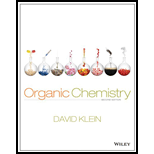
(a)
Interpretation:
The major product transformation should be drawn and identified for the given corresponding starting molecules by using its structures.
Concept introduction:
Addition Reaction: It is defined as
Elimination Reaction: It is just reverse reaction of addition where substituent from the given molecule is removed via E1 (the reaction depends only on the substrate involved in the reaction) or E2 (the reaction depends on both of the substituents in the reaction) mechanism.
Grignard Reaction: This is a organometallic reaction in different alkyl, aryl-magnesium halides add to a carbonyl group in an
Acid Catalyzed Hydration Reaction: The reaction involves breaking of π-bonds between carbon-carbon multiple bonds and addition of alcohol to more substituted position of carbon in the molecule.
Hydrolysis Reaction: This type of reaction involving the braking of a carbon-carbon triple, double bonds in a molecules using water.
(b)
Interpretation:
The major product transformation should be drawn and identified for the given corresponding starting molecules by using its structures.
Concept introduction:
Concept introduction:
Addition Reaction: It is defined as chemical reaction in which two given molecules combines and forms product. The types of addition reactions are electrophilic addition, nucleophilic addition, free radical additions and cycloadditions. Generally, compounds with carbon-hetero atom bonds favors addition reaction.
Elimination Reaction: It is just reverse reaction of addition where substituent from the given molecule is removed via E1 (the reaction depends only on the substrate involved in the reaction) or E2 (the reaction depends on both of the substituents in the reaction) mechanism.
Grignard Reaction: This is a organometallic reaction in different alkyl, aryl-magnesium halides add to a carbonyl group in an aldehyde and ketone. This reaction is an important for the conversion of carbon-carbon single
Acid Catalyzed Hydration Reaction: The reaction involves breaking of π-bonds between carbon-carbon multiple bonds and addition of alcohol to more substituted position of carbon in the molecule.
Hydrolysis Reaction: This type of reaction involving the braking of a carbon-carbon triple, double bonds in a molecules using water.
(c)
Interpretation:
The major product transformation should be drawn and identified for the given corresponding starting molecules by using its structures.
Concept introduction:
Addition Reaction: It is defined as chemical reaction in which two given molecules combines and forms product. The types of addition reactions are electrophilic addition, nucleophilic addition, free radical additions and cycloadditions. Generally, compounds with carbon-hetero atom bonds favors addition reaction.
Elimination Reaction: It is just reverse reaction of addition where substituent from the given molecule is removed via E1 (the reaction depends only on the substrate involved in the reaction) or E2 (the reaction depends on both of the substituents in the reaction) mechanism.
Grignard Reaction: This is a organometallic reaction in different alkyl, aryl-magnesium halides add to a carbonyl group in an aldehyde and ketone. This reaction is an important for the conversion of carbon-carbon single
Acid Catalyzed Hydration Reaction: The reaction involves breaking of π-bonds between carbon-carbon multiple bonds and addition of alcohol to more substituted position of carbon in the molecule.
Hydrolysis Reaction: This type of reaction involving the braking of a carbon-carbon triple, double bonds in a molecules using water.
Want to see the full answer?
Check out a sample textbook solution
Chapter 20 Solutions
Organic Chemistry
 ChemistryChemistryISBN:9781305957404Author:Steven S. Zumdahl, Susan A. Zumdahl, Donald J. DeCostePublisher:Cengage Learning
ChemistryChemistryISBN:9781305957404Author:Steven S. Zumdahl, Susan A. Zumdahl, Donald J. DeCostePublisher:Cengage Learning ChemistryChemistryISBN:9781259911156Author:Raymond Chang Dr., Jason Overby ProfessorPublisher:McGraw-Hill Education
ChemistryChemistryISBN:9781259911156Author:Raymond Chang Dr., Jason Overby ProfessorPublisher:McGraw-Hill Education Principles of Instrumental AnalysisChemistryISBN:9781305577213Author:Douglas A. Skoog, F. James Holler, Stanley R. CrouchPublisher:Cengage Learning
Principles of Instrumental AnalysisChemistryISBN:9781305577213Author:Douglas A. Skoog, F. James Holler, Stanley R. CrouchPublisher:Cengage Learning Organic ChemistryChemistryISBN:9780078021558Author:Janice Gorzynski Smith Dr.Publisher:McGraw-Hill Education
Organic ChemistryChemistryISBN:9780078021558Author:Janice Gorzynski Smith Dr.Publisher:McGraw-Hill Education Chemistry: Principles and ReactionsChemistryISBN:9781305079373Author:William L. Masterton, Cecile N. HurleyPublisher:Cengage Learning
Chemistry: Principles and ReactionsChemistryISBN:9781305079373Author:William L. Masterton, Cecile N. HurleyPublisher:Cengage Learning Elementary Principles of Chemical Processes, Bind...ChemistryISBN:9781118431221Author:Richard M. Felder, Ronald W. Rousseau, Lisa G. BullardPublisher:WILEY
Elementary Principles of Chemical Processes, Bind...ChemistryISBN:9781118431221Author:Richard M. Felder, Ronald W. Rousseau, Lisa G. BullardPublisher:WILEY





